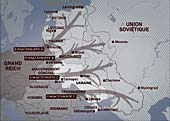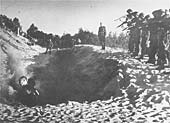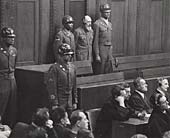- Exhibition presentation
- The Jews in Ukraine
- The start of a genocidal policy
- Radicalization of the genocide
- Father Patrick Desbois and Yahad-In Unum
- The stages of execution
- Panoramic views of the exhibition
The Holocaust by bullets - Shoah Memorial
Radicalization of the genocide
At the same time as massacres were being perpetrated in the Occupied territories, the Sonderkommandos and Einsatzkommandos continued their progress at the Front killing more and more systematically in Eastern Ukraine.
The radicalization of the Jewish massacre is clearly visible when one looks at the rise in execution figures. In the Zhytomir region, for example, 3 000 Jews were assassinated in July, 1941, another 10 000 in August and 27 000 in September. In recently conquered regions, massacres were immediately perpetrated on an enormous scale. In urban areas, over 10 000 victims often lost their lives, such as in Babi Yar (33 000).
Khrouchtchev assigned the Crimea to Ukraine at the outcome of the Second World War. At the time of the German invasion, it was an autonomous Soviet Republic, where roughly 65 000 Jews lived. When the Germans conquered the region, early November 1941, about 35 000 Jews turned to the East for refuge. About 8 000 Jews had been mobilized in the Red Army. The Germans therefore found the remaining 23 000 Jews still there, and quickly made them into the next victims of the genocidal machine, which was soon to be fully operational in the Soviet territories. Execution units scoured the countryside looking for Jews who may have escaped their grasp. Between mid-December and mid-January, the Nazis began to experiment with gassing vans as well.
Execution commando personnel quickly became psychologically exhausted by the more and more systematic massacres they were forced to commit. By the end of 1941, when the decision to kill all Jews in occupied Europe was taken, gas chambers were installed and perfected in the extermination centers located in Poland. But, in Ukraine, as in the rest of the Soviet Union, Nazi Reich wasn't able to do the same due to the proximity of the Front. More often than not, the railways were inadequate for the deportation of Jews towards extermination centers in Poland, which is why the ""Holocaust by bullets" continued in Ukraine until the end of the country's occupation by the Wehrmacht, early 1944. Just 20% of Ukrainian Jews were deported to Belzec, Sobibor and Auschwitz. The remaining 80% were killed by SS commando or their auxiliaries.
Nearly every Jew who did not manage to flee was killed in the space of two and a half years, between June, 1941 and December, 1943.
According to Ukrainian historian, Alexandre Kruglov: 500 000 persons were exterminated in 1941, over 700 000 in 1942, and 200 000 in 1943 before the Wehrmacht’s retreat in 1944. Just 20% of Ukrainian Jews were deported to Belzec, Sobibor and Auschwitz. The remaining 80% were killed by SS commando or their auxiliaries. One could say that about a third of Ukrainian Jews escaped the genocide, which means on the other hand that about one million, five hundred thousand were massacred.
The first Revisionism, by the Nazis themselves
The example of Subcarpathian Ukraine reveals how the Nazis assassinated or had the Jews assassinated as long as they were in control of part of the country. However, at the defeat of Stalingrad, retreat was envisaged and, along with it, came the necessity to erase all traces of their crime. The Nazis were the first Revisionists. The SS called on the commandos, commanded by Paul Blobel
(former head of the Einsatzkommando 4a), and regrouped under the camouflage name « Operation 1005 », to find the massacre sites and make the victims' corpses disappear. But the sites were so numerous that they couldn't all be found again before the arrival of the Red Army. The killings had not only been performed by the Einsatzgruppen, but also by the Ordnungspolizei, different Waffen SS units and the Wehrmacht. The NKVD Commissions, following the Red Army, were the first to supply systematic information on the genocide of the Jewish population.
The Nazis were unable, also, to make every trace and archive disappear. So many of the Einsatzgruppen reports had been distributed that it was impossible to destroy them all. The British had, since the Summer of 1941, intercepted transmissions by the Ordnungspolizei. These documents, as well as the trials in the Federal Republic of Germany from the end of the 1950's onwards, against former policemen, were the start of Patrick Desbois and the Yahad team's inquiries to localize the common graves of the "Holocaust by bullets".

Einsatzgruppen 'action' zones in the Soviet Union.
Source: Institut für Zeitgeschichte, Munich – Berlin, 1999.

Members of an Einsatzkommando firing at a group of men standing at the bottom of a trench. Circa : 1941-1942. Whereabouts unknown. Photographer unknown.
© USHMM, courtesy of Dokumentatioarchiv of the Oesterreichischen Widerstandes

Paul Blobel (1894-1951). Nuremberg, Germany, 1948.
© Coll. CDJC/Shoah Memorial